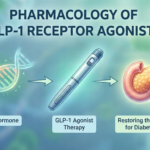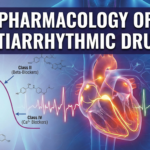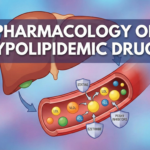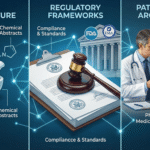Flecainide is a Class 1C antiarrhythmic agent widely used for rhythm control in atrial and ventricular arrhythmias, particularly in patients without significant structural heart disease. The following summarizes its pharmacology, clinical uses, cautions, and monitoring, referencing key pharmacology textbooks and clinical reviews in Vancouver style.
Overview
Flecainide is a potent blocker of cardiac sodium (Na+) channels, resulting in marked slowing of conduction in atrial, His-Purkinje, and ventricular tissue, with minimal effect on repolarization at therapeutic doses. Class 1C agents, including flecainide, exhibit slow channel dissociation kinetics and have pronounced use dependence (greater effects at faster heart rates).
Mechanism of Action
- Na+ Channel Blockade: Flecainide selectively binds to and blocks open state fast Na+ channels, leading to reduced phase 0 upstroke velocity in fast-response cardiac tissue. This causes significant slowing of intra-atrial, AV node, His-Purkinje, and ventricular conduction, visible on ECG as QRS widening.
- Potassium Channel Effects: Flecainide prolongs action potential duration by inhibiting delayed rectifier potassium channels (IKr), especially in atria and ventricles.
- Ryanodine Receptor Block: It inhibits RyR2-mediated calcium release from the sarcoplasmic reticulum, reducing triggered activity and afterdepolarizations – beneficial for rare indications like catecholaminergic polymorphic ventricular tachycardia (CPVT).
- Use Dependence: Its action intensifies during faster heart rates due to preferential binding in activated channels, providing effectiveness against reentrant tachyarrhythmias.
Electrophysiologic and ECG Effects
- Marked slowing of conduction (QRS widening), less effect on ERP and QT interval than Class 1A agents.
- PR interval may be prolonged due to AV nodal effects, and QRS becomes notably widened at higher doses and heart rates.
Pharmacokinetics
- Flecainide is well-absorbed orally and has a long half-life (~20 hours), allowing twice-daily dosing.
- Metabolized primarily via CYP2D6, with renal and fecal excretion. Dose reduction may be needed in renal impairment or slow metabolizers.
- Narrow therapeutic index; regular monitoring is required.
Therapeutic Indications
- Atrial Fibrillation (AF): First-line for pharmacologic rhythm control in paroxysmal AF without significant structural heart disease.
- Supraventricular Tachycardias: Includes PSVT, AVNRT, AVRT, and Wolff-Parkinson-White syndrome when ablation is not preferred or feasible.
- Ventricular Arrhythmias: Limited use for life-threatening, refractory ventricular arrhythmias in the absence of structural/ischemic heart disease, due to proarrhythmic risk.
Dosing and Formulations
- Oral tablets, started at a low dose and titrated based on therapeutic response and ECG.
- Dose adjustment in renal failure, hepatic disease, and in the elderly.
Contraindications and Precautions
- Absolute contraindications include structural heart disease (including history of MI, LV dysfunction), pre-existing conduction disease, and abnormal pacemaker thresholds.
- Can exacerbate bradycardia, heart block, and negative inotropy, and should not be used in patients with moderate/severe heart failure.
- CAST trial demonstrated increased mortality post-MI when using flecainide – therefore, only use in patients with essentially normal hearts.
Adverse Effects
- Proarrhythmia: Can precipitate monomorphic VT, especially in context of ischemic/structural heart disease.
- ECG changes: Excessive QRS widening, PR prolongation, and risk of heart block.
- Others: Dizziness, visual disturbances, gastrointestinal symptoms, and rarely elevated pacing thresholds in patients with pacemakers.
Drug Interactions
- Metabolism via CYP2D6; caution with inhibitors that may increase flecainide levels.
- Additive conduction slowing with other Na+ channel blockers and AV-nodal depressants.
Monitoring
- Baseline and serial ECG (focus on QRS width and PR interval).
- Clinical monitoring for signs of toxicity or arrhythmia exacerbation.
Clinical Pearls
- Flecainide may slow atrial flutter such that 1:1 conduction over AV node occurs; always coadminister with an AV-nodal blocking agent (e.g., beta-blocker or calcium channel blocker).
- Not for use in structural heart disease – strict selection minimizes risk.
- Dose reductions in renal/hepatic impairment.
Flecainide vs. Propafenone Comparison
| Feature | Flecainide | Propafenone |
|---|---|---|
| Primary Action | Potent Na+ channel blocker | Potent Na+ channel blocker |
| Beta-blockade | Minimal | Weak, clinically relevant |
| Use Dependence | Pronounced | Pronounced |
| Key ECG Effect | Major QRS widening | QRS widening; PR prolongation |
| Proarrhythmic risk | High in structural heart disease | High in structural heart disease |
| Unique Effects | RyR2 block (CPVT) | Beta-blockade (rate, bronchospasm) |
| Clinical Notes | Must combine with AV-nodal blocker | See flecainide (above) |
References (Vancouver Style)
- Arunachalam K, Lakshmanadoss U. Flecainide. StatPearls [Internet]. Treasure Island (FL): StatPearls Publishing; 2023 Aug.
- Modernized Classification of Cardiac Antiarrhythmic Drugs. Lei M et al. Circulation. 2018 Oct 22.
- Antiarrhythmic agents. Deranged Physiology. 2025 May 26.
- IBCC – Antiarrhythmics. EMCrit. 2025 Jul 30.
- Moreno JD, et al. Computational Model to Predict Effects of Class I Antiarrhythmic Agents. PMC3328405. 2011 Aug 30.
📚 AI Pharma Quiz Generator
🎉 Quiz Results
Medical Disclaimer
The medical information on this post is for general educational purposes only and is provided by Pharmacology Mentor. While we strive to keep content current and accurate, Pharmacology Mentor makes no representations or warranties, express or implied, regarding the completeness, accuracy, reliability, suitability, or availability of the post, the website, or any information, products, services, or related graphics for any purpose. This content is not a substitute for professional medical advice, diagnosis, or treatment; always seek the advice of your physician or other qualified health provider with any questions you may have regarding a medical condition and never disregard or delay seeking professional advice because of something you have read here. Reliance on any information provided is solely at your own risk.







